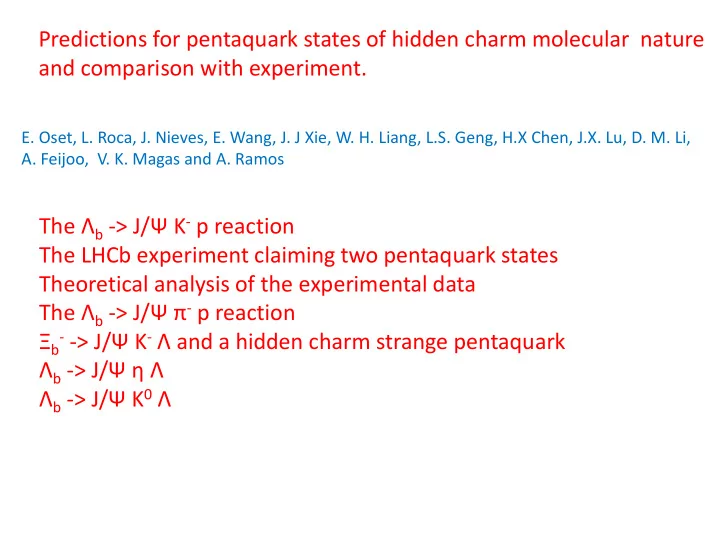

Predictions for pentaquark states of hidden charm molecular nature and comparison with experiment. E. Oset, L. Roca, J. Nieves, E. Wang, J. J Xie, W. H. Liang, L.S. Geng, H.X Chen, J.X. Lu, D. M. Li, A. Feijoo, V. K. Magas and A. Ramos The Λ b -> J/ Ψ K - p reaction The LHCb experiment claiming two pentaquark states Theoretical analysis of the experimental data The Λ b -> J/ Ψ π - p reaction - -> J/ Ψ K - Λ and a hidden charm strange pentaquark Ξ b Λ b -> J/ Ψ η Λ Λ b -> J/ Ψ K 0 Λ
L. Roca, M. Mai, E.Oset and U.G. Meissner, EPJC 2015 Cabibbo suppressed u c t Cabibbo d s b Λ b allowed u d quarks in I=0 (spectators) an s quark -> total I=0 u d quarks in I=0
Predictions for the K - p and πΣ mass distributions We need the meson-baryon transition amplitudes in coupled channels. We take them from the chiral unitary approach. We have there J/ ψ K - p , the final state in the LHCb pentaquark experiment One sees a clear peak for the Λ(1405) production in the πΣ invariant mass distribution
LHCb Collaboration Phys.Rev.Lett. 115 (2015) 072001 Note the large deviation from phase space for K - p While for J/ ψ p one has essentially Large concentration of strength around phase space except for the peak threshold
Two states claimed : Pc(4380), Γ =205 MeV ; Pc(4450), Γ=40 MeV Assignements : 3/2 - , 5/2 + ; 3/2 + , 5/2 - ; 5/2 + , 3/2 - …. Other less likeky How can the peak in J/ ψ appear? The J/ ψ N interaction is very weak !! J/ ψ c cbar J/ ψ J/ ψ J/ ψ D*bar D*bar D*bar c Nothing can be exchanged ρ D* D* p Σ c p uud Σ c Σ c p
Predictions for hidden charm Baryon states J J Wu, R Molina, E. O, B S Zou, PRL (2010) In s- wave: 3/2 - C W Xiao , J Nieves , E. O, PRD 2013 : D*bar Σ c * channel included
L. Roca, J. Nieves, E. O PRD 92, 094003 (2015) 2M R
This assumes the two pentaquark Reanalysis including more resonances states to be in S-wave in J/ Ψ p L. Roca and E. O, 1602. 06791 (1/2 - )
Fit with two Pentaquarks Both in s-wave in J/ Ψ , for instance 3/2 -, 3/2 -
Fit removing the Pc(4380)
This could be 3/2 - , 5/2 + All fits prefer to have the wide state with negative parity, interfering with the Λ(1405)
Lucky experimental analysis T 11 and T 12 are not proportional If V 12 is small 11: Kbar N -> Kbar N 12: Kbar N -> πΣ and recall the Λ(1405) has two poles.
[LHCb Collaboration], JHEP 1407, 103 (2014) Peak at the same energy as in Note: No Δ(1232) !! I=1/2 if u,d quarks are in I=0 and are spectators x d Λ b
Wang, Chen, Geng, Li, E. O. , 1512.01959 PRD 2016
More pentaquarks? Wu, Molina, E.O. and Zou , PRC 84 (2011)
Chen, Geng, Liang, E.O. Wang, Xie, 1510. 01803, PRC 2016
Feijoo, Magas, Ramos, E. O. , 1512.08152
Lu, Wang, Xie, Geng, E. O. , 1601.00075, PRD 2016
Conclusions : Predictions for Λ b -> J/ ψ Λ(1405) made prior to LHCb experiment Preditions for D*bar Σ c and D*bar Σ * c bound states also made before. The combination of both matches recent findings of experiment A recent theoretical analysis backs the experimental claims for two pentaquark states. The Λ b -> J/ ψ π - p decay shows the same peak as the Λ b -> J/ ψ K - p . Preditions are made for different reactions producing J/ Ψ Λ mass in the final state. The mass distribution of this pair exhibits clear signals of new pentaquark states with hidden charm and strangeness.
It is not trivial that the K - p and J/ ψ p distributions can be related like that D 0 K - c s b c u Λ b u Λ c I=0 I=0 d d Since D*bar Σ c is the main channel one should start from this production and then make transition to J/ ψ p, but this configuration is now allowed D*bar Λ c is allowed but it is has a very small strength in the wave function This leaves only J/ ψ p to initiate the interaction to produce the resonance The D*bar Σ c or D*bar Σ * c picture endures all tests of experiment: mass and width, spin parity 3/2 - acceptable, coupling of resonance to J/ ψ acceptable, nontrivial relation of J/ ψ p and K - p distributions established.
Wang, Li , Q Zhao, arXiv 1508.00339 Photoproduction of J/psi Theory assuming that only 5% of the width goes into J/psi N
PRD 2015 Lower curve is for Γ =100 MeV (exp value)
Recommend
More recommend